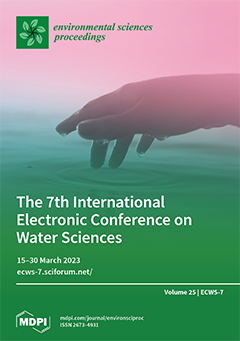The aim of our study is the modeling at the field level of the soil erodibility (
K factor) by water (rainfall and irrigation) on traditional tillage (CoTl) and no-tillage (NoTl) plots cultivated with
Helianthus annuus utilizing plot observations, soil sampling laboratory analyses,
[...] Read more.
The aim of our study is the modeling at the field level of the soil erodibility (
K factor) by water (rainfall and irrigation) on traditional tillage (CoTl) and no-tillage (NoTl) plots cultivated with
Helianthus annuus utilizing plot observations, soil sampling laboratory analyses, GIS, precision agriculture (PA), and Kriging geostatistical modeling. A split-plot layout consisting of four handlings × three replicates of trial blocks (with a southeast facing 7.5% slope) was used. Grid template surface soil core (0.0–5.0 cm) samples were taken to characterize the textures (sandy, silty, clayey, very fine sandy, and gravelly), organic matter concentrations, and the soil’s microstructure and water permeability categories. One GPS satellite tracker system was utilized to define the sampled positions, and 40 soil cores were air-dried and sieved with a 2 mm sieve to identify the soil’s mechanical microtexture using the Bouyoucos methodology. The organic matter was extracted by chemical oxidation with 1 mol L
−1 K
2Cr
2O
7 and titration of the remaining reagent with 0.5 mol L
−1 FeSO
4. The soil microstructure and permeability categories were defined following the USDA classification system. The soil erodibility by water modeling of
K (Mg·ha·h·ha
−1·MJ
−1·mm
−1) was derived according to the Wischmeier nomographic method by incorporating it into a developed GIS geospatial model using Kriging geostatistics. The statistical results of the ANOVA test (
p = 0.05) among the soil erodibility datasets showed significant differences between the two tillage systems, as well as between the four management treatments. Moreover, it was found that the no-tillage (NoTl) plots and the treatment of no tillage plus vegetative coverage were the best tillage and agricultural practices for hillslope farm fields and can be considered environmentally friendly farming methods to curb soil erodibility by water, reduce runoff hazard, and maintain the soil’s environment and its beneficial nutrients.
Full article



